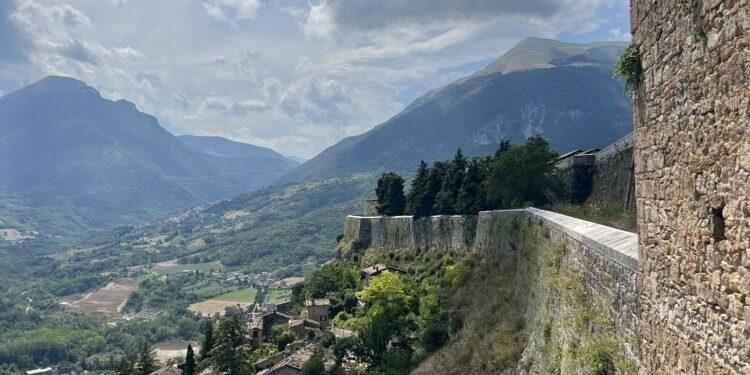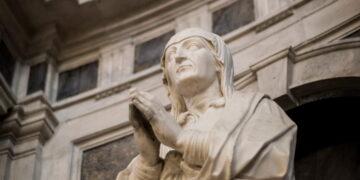Contents
Questo articolo è disponibile anche in:
There are two aphorisms concerning history popularly known: “Historia magistrae vitae” and “History is written by the victors“. The siege of Civitella del Tronto occured between October 26th 1860 and March 20th 1861 encloses both. The Royal Neapolitan army’s resistance stood out as a witness of the strong rejection from most of the South towards the forceful Piedmontese annexation.
The Savoy victory, though, swept under the carpet Civitella’s defense and rewrote deliberately the history of that controversial process that was the Risorgimento in an ideal-patriottic manner. By now after 162 years from the proclamation of Unification of Italy, the truth of the defeated is being shed light on more and more in post-modern Europe torn apart between nihilism and ridiscovery of its own identities.
“Fidelissima”
The fortress of Civitella del Tront was a symbol first of all. It used to defend the northermost border of the Kingdom of Naples since immemorial times, immerse among the proud tops of Abruzzo, the green hills of Piceno beyond the Tronto and the blue color of the Adriatic Sea at 589 meters above sea level. The stronghold is embedded on a hill that stands out in its surroundings, having cliffs as its sides. Its natural shape bestows it the flawless role of Tronto’s guardian.
It was seamlessly protagonist of arms events during the centuries, as the sieges of 1557, 1799 and 1806 show. It was always affected by French troops’ attack on these occasions, among which the 1806’s one was particularly meaningful: Irish major Matthew Wade defended heroically the stronghold here for over three months against Murat’s jacobin troops. The umpteenth act of loyalty from Civitella allowed it to be awarded with “Fidelissima” title by king Francis II.

After 1806’s events, life within the town whiled away very calmly. The peace garrison was made up of around a hundred men among officers, NCOs and privates. Whole families and soldiers lived here by aging inside those walls that would assume their military duty sooner or later.
Call to arms did not delay too long. A new conflict came to disturb that quietness of Sunday masses and balls amongst soldiers and civilians. It was 1860. 54 years had passed since major Wade’s days of glory. This time French did not knock at Civitella’s gates, but “the most French among Italians”: the Piedmontese.
Here come the Mille
Civitella del Tronto’s telegraph brutally shook the peacetime’s warm succession. Garibaldi had landed in Marsala. It was May 15th 1860. This officially started that process of conquest and disruption of the Kingdom of the Two Sicilies.
While Civitella was beginning to ready what was needed for its defense, news from Sicily and the rest of the kingdom were dramatic. A good deal of Neapolitan generals betrayed the Crown, so the Royal Navy and several members of the Bourbon government did. There were multiple reasons: someone did that out of mere personal interest, someone out of corruption, someone else out of adherence to the ideal of a new united homeland according to masonry’s likings.

Officers took out physically their own generals in the most drammatic cases when compromise with enemy was too evident. The Royal Navy was handed over to Piedmontese admiral Persano and Don Liborio Romano, Minister of domestic affairs and mason, gave up Naples to Garibaldi on September 7th 1860. The former Bourbon minister exploited deliberately camorra in order to handle the capital’s public order in a phase of power shift.
Meanwhile king Francis II and queen Maria Sophie sought shelter in Gaeta where they hoped to reorganize the army and obtain reinforcements from any of European powers. Bourbon forces succeeded in regrouping in September and the Neapolitan army led by general Giosué Ritucci lined up on Volturno river, ready to battle out with 40.000 men. On October 1st 1860, the Battle of Volturno raged on for twelve hours between Bourbon soldiers and Red Shirts whose strife’s outcome was uncertain.
General Ritucci did not counterattack the worn out Garibaldians despite king’s insistent pressures and fatally lost the momentum. He put this forward due to the need to preserve his forces in view of the upcoming descent of the Savoy regular army from the North. This excess of careful temporizing turned out to be lethal, allowing Garibaldians to catch their breath and Victor Emmanuel II to cross Tronto and meet Garibaldi in Teano.
Only three valiant fortresses remained at this point to defend the honor of the Crown: Messina, Gaeta and Civitella. Any further resistance would purely be a demonstration of bravery and loyalty to the ideal of Throne and Althar that had been the substratum of the whole traditional European Civilization.
Civitella’s last lily
The siege officially began on October 26th 1860. Civitella was manned by 530 combatants at that moment, many of whom had just flocked to reinforce the garrison a few weeks earlier. The fortress was commanded by major Luigi Ascione, whose ambiguous intentions cost him a preemptive detention. The rule was passed onto Neapolitan captain Giuseppe Giovene, arrived there waiting for the Piedmontese. Gendarmerie officer, former artilleryman, he proved to be an intelligent and brave commander with a temperate character.
He was the one to arrange the last preparations before the besieging forces’ arrival and his inspired guide played a pivotal role for the hard-fought town’s defense. Like in any memorable historical moment, several novel figures took part in those eschatological months for the Bourbon kingdom. Mystical priests, fearless farmers, loyal soldiers and opportunists composed the frame of Francis II’s last autumn.
Many civilians voluntarily took arms right as soldiers due to Abruzzo peoples’ atavic loyalty to the Neapolitan crown. Even so-called “briganti” assisted the Bourbon army’s and armed populace’s efforts, by providing skirmish actions and supplies. Meanwhile invasor’s brutality began to reveal in all its violence: Major General Augusto Ferdinando Pinelli smeared himself with heinous crimes against the Southern populace.
Towns like Pizzoli, San Vittorino, Campli were subject to military power because of their stubborn loyalty towards the king. Rapes, plunders, mass shootings were committed in order to humiliate and attempt to bend the inhabitants’ resistance to the invasion. Several priests were killed inside their churches desecrated on behalf of that anticlerical liberalism that Neapolitans had already widely known and fought in 1799 and 1806.

This violence was not out of the blue. Many Piedmontese as general Cialdini and De Sonnez perceived a strong adversion towards the Southern people. The former’s deep hate was so marked that Giovanni Nicotera uttered about Cialdini: “Proclamations by Cialdini and the other heads are no less worthy than Tamerlane, Genghis Khan or even Attila“.
Despite the dire situation, Civitella continued to resist heroically. Sallies led by captain Giovene as well as sudden raids from briganti allowed to perform some minor tactical victories over Savoy troops. Civitella’s resistance was praised by sovereign Francis II himself who managed to reach out for the defenders in January through a certain Filippo Enea, who managed to miraculously reach besieged Gaeta.
Giovene was promoted colonel, so all other soldiers were due to their heroism. Ruling house’s banner could not resist forever, though. Gaeta yielded on February 13th, Messina did on March 14th. Chaos broke out in Civitella, because such news was considered as a lie from the enemy so that even the Fidelissima surrendered. Giovene left the fortress in mid-February because the fall of Gaeta with the following king’s escape to Rome would turn legally Civitella’s soldiers into brigands. This would strip them out of any military right.
A honorable surrender’s proposal from the Neapolitan colonel was turned down by the rest of the garrison that carried on the struggle. On Februrary 25th, the last important military happening took place following a determined assault from Savoy soldiers, anticipated by a very violent bombardment on the previous day. Attackers were again repelled even thanks to the fact that all gates had been walled up.
In the meantime, Victor Emanuel II was proclaimed King of Italy on March 17th. That proclamation was still morally halted by the heroic Abruzzese resistance, though. Fidelissima was holding on for almost six months by then and the Bourbon banner was still waving on its top. The sunset was however turning into a dusk.

On March 20th 1861, Civitella’s fortress capitulated once for all in unclear circumstances and with it the Kingdom of the Two Sicilies. Probably an overnight treason from officer Ascione was not seen by the exhausted garrison. That kingdom established by Norman Roger II in 1130 ceased to exist. The Royal stronghold’s flag was never found, buried in history’s meanderings forever. However, resistance was not over yet: bands of loyalists, monarchists and common criminals kept on bearing arms for more than ten years. This was named “brigantaggio” in the post-unification historiography.
An endless siege: (dis)united Italy
Civitella’s events have been sifted, right as the entire Risorgimento’s process, only in the latest years without mythical sentimentalisms. Atrocities from Savoy generals, bersaglieri as well as all but patriotic intentions from part of the Piedmontese élite have come into surface. The truth of a bloody and not at all unanimous Risorgimento has awakened a revengeful sentiment that was asleep in many Southern Italians’ hearts.
The kingdom’s wealth’s dismantlement, the next mass emigration of “terroni” to the North with a subsequent attrition between locals and immigrants, other than a generic cultural difference did everything but worsen that never-healed wound. The North overcame the South, but the fromer has never wanted to put the latter on an equal level. A creative palingenesis of a new common Homeland born through the union of the South and the North never occured.
Actually, the imposition of a victorious cultural model (the Northern one) over a losing model considered inferior (the Southern one) ensued. Southern labor, alongside the most brilliant minds, went to build up the scaffolding of that late Italian industrial revolution that came to life through the birth of the industrial triangle Milan-Turin-Genoa.
The polarization of human, industrial and cultural resources into the North of the country laid conditions for a systematic impoverishment of the Mediterranean regions. Eventually, we got to a swift depletion of historically more thriving regions because of capitalistic process’ extremization of the economical polarization, nowadays focused mainly on Milan. The current status of Rome, a capital crippled between corruption and immobilism, represents perfectly the shortcomings of nourishment in 21st century’s Italy.
Our Homeland is weaker and weaker demographically and economically, cast away in a world in which it can no longer find a purpose. The predatory attitude chosen by Piedmont towards the Kingdom of the Two Sicilies eventually showed up again in different shapes under the American dominion.
Two solutions are remaining: becoming truly “Brothers of Italy” by finding ourselves in an actual united volition or ending up as Civitella’s soldiers, crushed by the relentless advance of a new world. The second option would be this time way less honorable, neverthless.



















